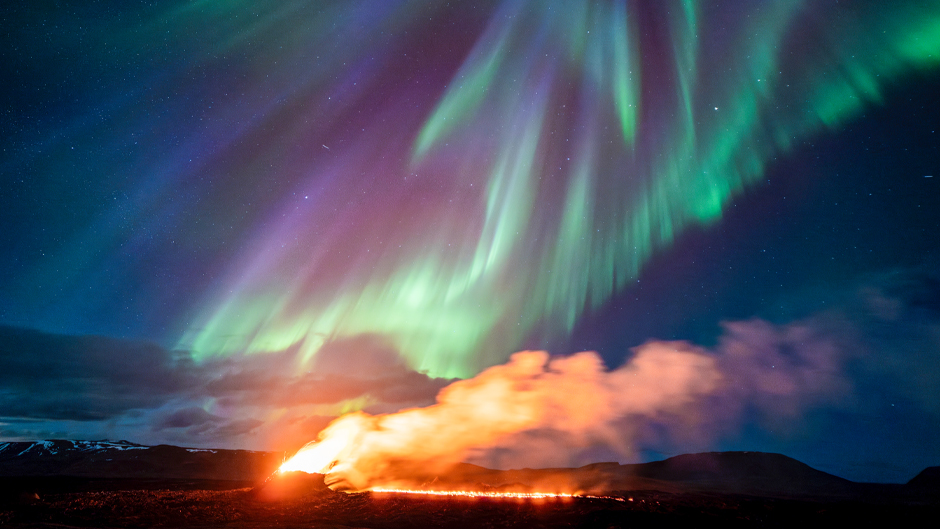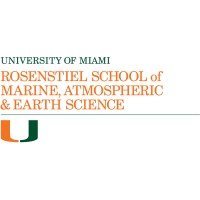From The Rosenstiel School of Marine and Atmospheric and Earth Science
At
4.24.24
Robert C. Jones Jr.
rcjones@miami.edu

A view of the eruption area with the northern lights dancing in the sky near the town of Grindavik, Iceland, on April 16. Photo: The Associated Press
Beneath an island named for ice flows some of the hottest rivers of all.
Iceland, home to some of the largest glaciers in Europe, sits atop a volcanic hot spot, with magma regularly breaching the surface, creating long, narrow fissures that spew lava, ash, and smoke.
“It’s a geological wonder on steroids,” Falk Amelung, a professor of marine geosciences at the University of Miami Rosenstiel School of Marine, Atmospheric, and Earth Science, said of the land of fire and ice, which boasts some 32 active volcanoes. “It is part of the mid-Atlantic ridge, which is a massive crack located on the ocean floor caused by the separation of the North American and Eurasian tectonic plates.

When those plates pull apart, new magma rises, and that’s what triggers volcanic activity.”
A series of eruptions has rocked the island nation’s Reykjanes Peninsula since 2021, when volcanoes that had been dormant for almost 800 years suddenly roared to life, spitting out steam and lava.
Since late 2023, the eruptions have been especially frequent. Only days ago, the Icelandic Meteorological Office issued lava warnings, reporting that more volcanic activity near the Sundhnúkur area may be imminent.
Could climate change be contributing to the increase in Iceland’s volcanic activity?
Amelung believes so.
“There are two mechanisms at work,” the marine geoscientist said. “Large parts of Iceland were covered by ice caps. When they melt, there is less pressure on the magma chamber. So, for the magma it is easier to break the rock and travel to the Earth’s surface. This has caused the increase in volcanic activity in central Iceland in the past two decades.
“The other mechanism,” he continued, “is that hot rock melts when the overburden pressure reduces. This can be achieved by upward movement of the rock mass, which is the typical melt generation mechanism at hot spot volcanic systems, or directly by the melting of an overlying ice cap.”
Amelung is quite familiar with Iceland’s volcanology, having visited the island to use data from satellite-measured ground uplift to study its retreating ice caps.
He continues to be enthralled by its geology and the way in which climate affects it.
“Geologically speaking, it’s an amazing place, not only because of its tectonics but also because of the glaciers that respond rapidly to changes in the climate,” Amelung said. “During cold periods lasting a few hundreds of years, winter sea ice develops, temperatures drop dramatically, and Iceland freezes over and develops an ice sheet. There have been several little ice ages in the recent geological history when Iceland was partially or fully glaciated. And the glaciations are associated with changes in the ground surface elevation. When Iceland is covered by an ice sheet, the weight presses the ground down by up to 500 meters.”
Currently, Iceland’s Vatnajökull ice cap, which is the largest glacier in Europe, loses about 1 meter of ice per year. As a result, the ground is uplifting by 2 to 3 centimeters annually, according to Amelung. “And when the ice melts, volcanic activity increases,” he said.
Amelung recently taught a class on the geology of the Galápagos Islands as part of the Rosenstiel School’s UGalapagos program for undergraduates, comparing for students the similarities and differences between the volcanology of that famous archipelago and that of Iceland.
“They are both oceanic hot spot volcanic systems where the melt is generated by upwelling material in the Earth’s mantle,” he said. “But Iceland is sitting on a divergent plate boundary where new crust is generated as two tectonic plates move apart, which makes it easy for magma to escape to the Earth’s surface. In contrast, under the Galápagos volcanoes, the magma is accumulating in big magma chambers and the volcanoes erupt once the pressure in the chamber is high enough to rupture the surrounding rock.”
Amelung noted that the volcanism on both islands is of a basaltic nature. “The magmas are very hot and flow readily because they have low viscosity,” he said. “Therefore, the eruptions are not violently explosive. But the large lava flows can destroy property as we have seen in Iceland.”
See the full article here.
Comments are invited and will be appreciated, especially if the reader finds any errors which I can correct.
five-ways-keep-your-child-safe-school-shootings
Please help promote STEM in your local schools.

The Rosenstiel School of Marine and Atmospheric and Earth Science is an academic and research institution for the study of oceanography and the atmospheric sciences within the University of Miami. It is located on a 16-acre (65,000 m^2) campus on Virginia Key in Miami, Florida. It is the only subtropical applied and basic marine and atmospheric research institute in the continental United States.
The Rosenstiel School of Marine and Atmospheric Science receives over $50 million in annual external research funding. Their laboratories include a salt-water wave tank, a five-tank Conditioning and Spawning System, multi-tank Aplysia Culture Laboratory, Controlled Corals Climate Tanks, and DNA analysis equipment. The campus also houses an invertebrate museum with 400,000 specimens and operates the Bimini Biological Field Station, an array of oceanographic high-frequency radar along the US east coast, and the Bermuda aerosol observatory. The University of Miami also owns the Little Salt Spring, a site on the National Register of Historic Places, in North Port, Florida, where RSMAS performs archaeological and paleontological research.
Up until 2008, RSMAS was solely a graduate school within the University of Miami, while it jointly administrated an undergraduate program with UM’s College of Arts and Sciences. In 2008, the Rosenstiel School has taken over administrative responsibilities for the undergraduate program, granting Bachelor of Science in Marine and Atmospheric Science (BSMAS) and Bachelor of Arts in Marine Affairs (BAMA) baccalaureate degree. Master’s, including a Master of Professional Science degree, and doctorates are also awarded to RSMAS students by the UM Graduate School.
The Rosenstiel School’s research includes the study of marine life, particularly Aplysia and coral; climate change; air-sea interactions; coastal ecology; and admiralty law. The school operates a marine research laboratory ship, and has a research site at an inland sinkhole. Research also includes the use of data from weather satellites and the school operates its own satellite downlink facility. The school is home to the world’s largest hurricane simulation tank.
The University of Miami is a private research university in Coral Gables, Florida. The university enrolls over 18,000 students in 12 separate colleges and schools, including the Leonard M. Miller School of Medicine in Miami’s Health District, a law school on the main campus, and the Rosenstiel School of Marine and Atmospheric Science focused on the study of oceanography and atmospheric sciences on Virginia Key, with research facilities at the Richmond Facility in southern Miami-Dade County.
The University of Miami is now a member of The Association of American Universities
The university offers 132 undergraduate, 148 master’s, and 67 doctoral degree programs, of which 63 are research/scholarship and 4 are professional areas of study. Over the years, the university’s students have represented all 50 states and close to 150 foreign countries. With more than 16,000 full- and part-time faculty and staff, The University of Miami is a top 10 employer in Miami-Dade County. The University of Miami’s main campus in Coral Gables has 239 acres and over 5.7 million square feet of buildings.
The University of Miami is classified among “R1: Doctoral Universities – Very high research activity”. The University of Miami offers a large library system with over 3.9 million volumes and exceptional holdings in Cuban heritage and music.
The University of Miami also offers a wide range of student activities, including fraternities and sororities, and hundreds of student organizations. The Miami Hurricane, the student newspaper, and WVUM, the student-run radio station, have won multiple collegiate awards. The University of Miami’s intercollegiate athletic teams, collectively known as the Miami Hurricanes, compete in Division I of the National Collegiate Athletic Association. The University of Miami’s football team has won five national championships since 1983 and its baseball team has won four national championships since 1982.
Research
The University of Miami is classified among “R1: Doctoral Universities – Very high research activity”. The University of Miami has received over $195 million in federal research funding, including $131.3 million from the Department of Health and Human Services and $14.1 million from the National Science Foundation. Of the $8.2 billion appropriated by Congress in 2009 as a part of the stimulus bill for research priorities of The National Institutes of Health, the Miller School received $40.5 million. In addition to research conducted in the individual academic schools and departments, Miami has the following university-wide research centers:
The Center for Computational Science
The Institute for Cuban and Cuban-American Studies (ICCAS)
Leonard and Jayne Abess Center for Ecosystem Science and Policy
The Miami European Union Center: This group is a consortium with Florida International University (FIU) established in fall 2001 with a grant from the European Commission through its delegation in Washington, D.C., intended to research economic, social, and political issues of interest to the European Union.
The Sue and Leonard Miller Center for Contemporary Judaic Studies
John P. Hussman Institute for Human Genomics – studies possible causes of Parkinson’s disease, Alzheimer’s disease and macular degeneration.
Center on Research and Education for Aging and Technology Enhancement (CREATE)
Wallace H. Coulter Center for Translational Research
The Miller School of Medicine receives more than $200 million per year in external grants and contracts to fund 1,500 ongoing projects. The medical campus includes more than 500,000 sq ft (46,000 m^2) of research space and the The University of Miami Life Science Park, which has an additional 2,000,000 sq ft (190,000 m^2) of space adjacent to the medical campus. The University of Miami’s Interdisciplinary Stem Cell Institute seeks to understand the biology of stem cells and translate basic research into new regenerative therapies.
The Rosenstiel School of Marine and Atmospheric Science receives over $50 million in annual external research funding. Their laboratories include a salt-water wave tank, a five-tank Conditioning and Spawning System, multi-tank Aplysia Culture Laboratory, Controlled Corals Climate Tanks, and DNA analysis equipment. The campus also houses an invertebrate museum with over 400,000 specimens and operates the Bimini Biological Field Station, an array of oceanographic high-frequency radar along the US east coast, and the Bermuda aerosol observatory. The University of Miami also owns the Little Salt Spring, a site on the National Register of Historic Places, in North Port, Florida, where RSMAS performs archaeological and paleontological research.
The University of Miami built a brain imaging annex to the James M. Cox Jr. Science Center within the College of Arts and Sciences. The building includes a human functional magnetic resonance imaging (fMRI) laboratory, where scientists, clinicians, and engineers can study fundamental aspects of brain function. Construction of the lab was funded in part by a $14.8 million in stimulus money grant from the National Institutes of Health.
The university receives over $161 million in science and engineering funding from the U.S. federal government, the largest Hispanic-serving recipient. $117 million of the funding was through the Department of Health and Human Services and was used largely for the medical campus.
The University of Miami maintains one of the largest centralized academic cyber infrastructures in the country with numerous assets. The Center for Computational Science High Performance Computing group has been in continuous operation since 2007. Over that time the core has grown from a zero HPC cyberinfrastructure to a regional high-performance computing environment that currently supports more than 1,200 users, 220 TFlops of computational power, and more than 3 Petabytes of disk storage.



